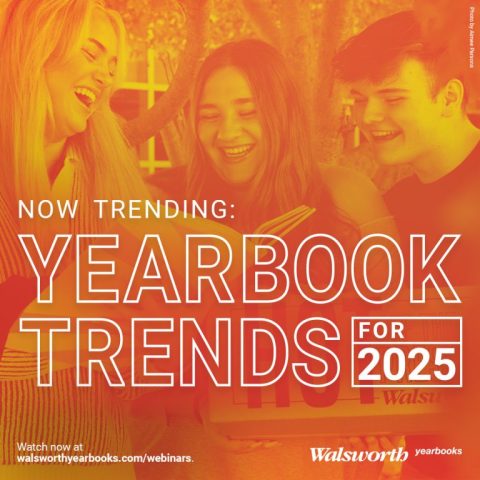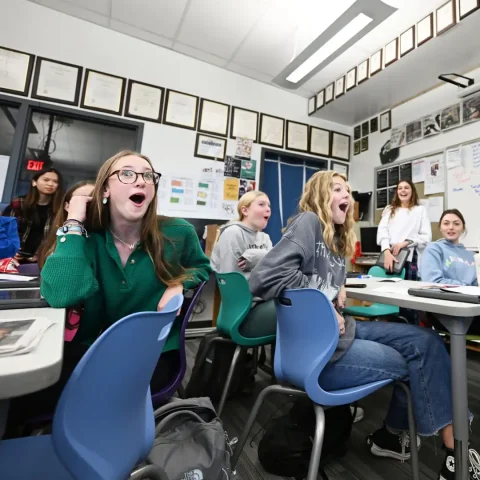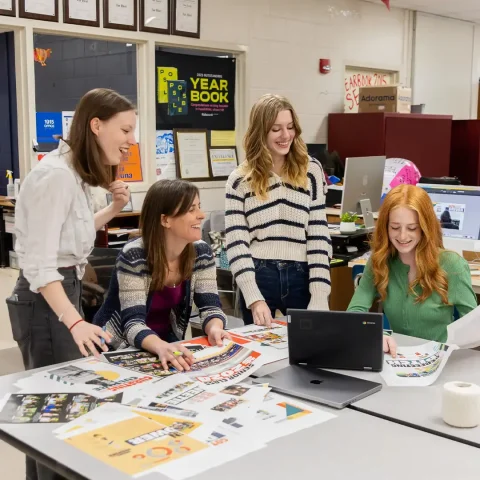Our latest video series, “Now Trending: Yearbook Trends for 2025” highlights patterns in design trends that should be considered when planning for your next yearbook. Hosts Jim Jordan and Sabrina Schmitz, CJE, meet with three experts in the field: advisers Emily Arnold, CJE, and Tucker Love, as well as Walsworth Graphic Design Supervisor Zach Field.
Find Inspiration Everywhere
Your journey in developing the look of your book is contingent on keeping your eyes and minds open. Our speakers in our trends series discuss ways to pull inspiration and places to keep an eye on.
From Emily
Encourage students to look everywhere for inspiration when designing their yearbooks. Find inspiration from commercials, print design, music, artwork and more. When exploring options for their theme, Aledo found inspiration from a 1971 documentary trailer and pulled different elements like halftone dots, sound waves and layered photos to create their design.
From Tucker
Magazines can be a vital resource when seeking inspiration. Barnes & Noble is a good starting point, where you can find magazines with a variety of designs, fonts, and creative approaches. Instagram and TikTok are also hot spots for trendy marketing. Yearbook staffs should pay attention to advertising, such as the Grammys promos, for interesting design choices that could translate to yearbooks.
From Zach
Look past your stack of favorite yearbooks for design inspiration. By exploring different media, students gain exposure to new trends and styles that they can potentially incorporate into their yearbook designs. Following designers on platforms like Behance and Dribbble help your staff stay up-to-date on the latest trends and see what other creatives are working on. Branching out to various visual media exposes students to fresh ideas and helps prevent yearbook designs from becoming stale or repetitive from year to year.
Using Type To Set a Tone
From Emily
Starting with something as simple as an ESPN commercial can set off your inspiration journey. Explore variable fonts, which can be manipulated in real time by adjusting weight, width and other properties. Finding a great font sets the design apart. Take a look at bold, playful typography that can add personality to your layouts.
From Tucker
Using unique and quirky fonts can set the tone and vibe for a yearbook. Various typefaces from magazines could work well for headlines due to their unique letterforms and personality. Condensed and skinny serif fonts, as well as fonts with unconventional letter shapes, can take your theme to the next level. Find a font that truly fits the personality and vision of each unique yearbook staff, rather than worrying about what others think. Experiment with subtle font details that can make a big impact when used cohesively throughout a book’s design.
From Zach
Thicker, bolder sans serif and serif fonts are making a comeback as part of the 1970s nostalgia trend. Thicker, funkier fonts provide an alternative to the very thin, modern sans serifs that have been overused in recent years. We are also seeing a trend of 3D and textured typography, where fonts take on dimensionality and texture.
For yearbook designs, this could mean experimenting with fonts that have an illusion of depth or incorporating texture overlays into typography. Ultimately, your staff should be exploring a wide variety of font styles, including thicker options as well as 3D and textured treatments, as part of keeping yearbook designs feeling fresh and on-trend.
Emerging Trends
From Emily
Asymmetrical shapes and bright, contrasting colors are being used for a modern aesthetic in designs. Bold, maximalist designs with high contrast and attention-grabbing visuals are also trending, as well as bold minimalism. Playful, almost 3D typography that adds personality to layouts is another trend. Natural designs incorporate asymmetrical, bold takes on plant and nature-inspired graphics. Bold colors, shapes and graphics being used across layouts in both large and small applications create visual variety.
From Tucker
Using subtle gradients in yearbook design can enhance the look of your spreads. Gradients can suggest movement from page to page. Gradients should act as a “supporting actor” in design rather than the main focus. You can also explore incorporating analog or handmade elements digitally, through techniques like photographing physical creations made with markers. Find your inspiration and stick to a cohesive direction tailored to your staff’s personality and vision.
From Zach
Trends such as vibrant colors and bold color palettes are making their way into the designscape, leaving behind more muted tones. Organic and geometric shapes are used prominently from illustrations to typography and 3D elements are becoming more prevalent, especially in dimensional and textured typography which can add visual interest while being complex to achieve.
Nostalgia for the 1970s is coming through with warmer tones, bolder serifs, and funkier aesthetics inspired by that era. Additionally, anti-design was noted as emerging as a loose maximalist approach that plays with design rules, which should be used sparingly to avoid illegibility. However, it was advised to first understand design principles like balance, hierarchy and contrast before incorporating trends.
Get Inspired With Your Staff
It’s never too early to begin preparing for your next yearbook. Be sure to catch all three videos in the Trends for 2025 video series. Getting inspired is an important first step, so gather your staff together to watch the presentations. Discuss the trends and principles highlighted to get everyone on the same page. Brainstorm creative ways you could experiment with trends through covers, spreads or other design elements.
Having your staff actively engaged from the beginning will help kickstart the planning process and ensure your book stays on-trend and on-message throughout the year.





